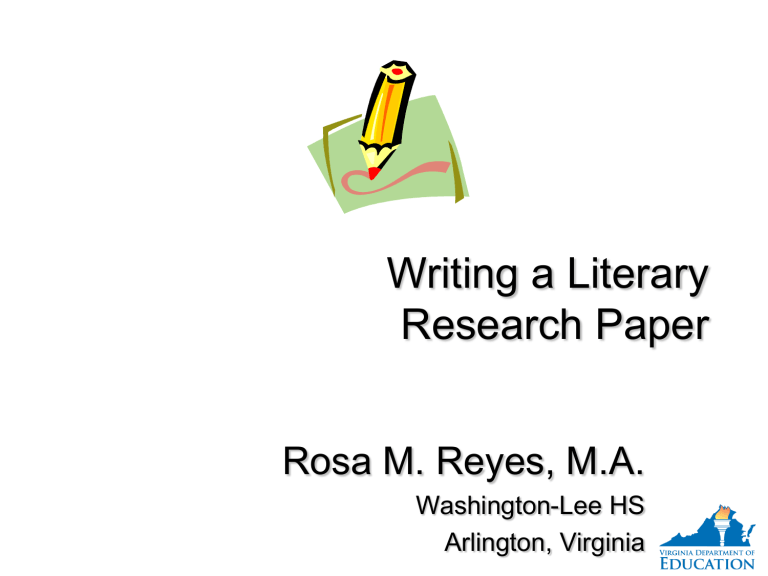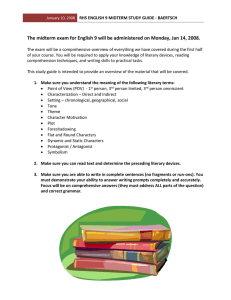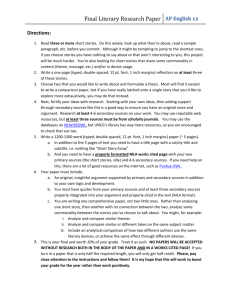File

Writing a Literary
Research Paper
Rosa M. Reyes, M.A.
Washington-Lee HS
Arlington, Virginia
Literary Research Writing
To begin: You need a topic !
To select a topic: You can …
Focus on an Author (Ex: John Steinbeck)
Focus on a Work (Ex: The Red Pony)
Focus on a Biography (Ex: Steinbeck’s life and various books he’s written)
Focus on the Historical (Ex: The Great
Depression…)
Focus on a Literary (technique) (Ex:
Steinbeck ’s use of imagery, point of view, flashback or foreshadowing, etc… in his novels.)
Literary Research Writing
Once you have a topic selected, you need to
FOCUS your SUPPLEMENTAL RESEARCH :
Ask yourself…
1.
Is enough information available on the topic? (You should be able to find/use at least 3-5 good sources; i.e. books, articles, non print sources —ABOVE THE PRIMARY SOURCE—THE NOVEL)
2.
Is the topic OBJECTIVE (i.e. does it relate to the assignment & can you write about it without including too much opinion if not a persuasive paper)?
3.
Is the topic unique and interesting or does it simply restate other people ’s ideas?
4.
Does the topic need additional research to support it?
5.
How can I use the supplemental (additional) research to help prove my thesis?
Literary Research Writing
To help FOCUS the TOPIC , consider:
Purpose: Your reason for writing this
Audience: Your readers: peers
& me
Tone: Using formal tone; 3 rd person; appropriate grammar and spelling
Example: 1 st POV vs 3 rd POV
1 st POV: I feel Hosseini ’s use of the kite is a symbol for the struggle Afghans faced during the political uprisings that changed their way of life and customs by restricting their personal freedoms. A kite, like the basic fundamental right to freedom and the pursuit of happiness, is taken from them which I think is the root cause of all the conflicts we see in Afghanistan today…
3 rd POV: Hosseini ’s use of the kite is a symbol for the struggle the people of Afghanistan faced during the political uprisings that changed their way of life and customs by restricting their personal freedoms. A kite, like the basic fundamental right to freedom and the pursuit of happiness, is taken from them which triggers the root cause of all the conflicts seen in Afghanistan today… .
Literary Research Writing
The paper expectations : This will be a Writing/Project Grade
A-B range : 3+ pages, typed, double-spaced, with a
Bibliography page or Work Cited
(page is not part of TOTAL range)
C-D range : 1-2 pages, typed, double-spaced, with a
Bibliography page or Work Cited
(page is not part of TOTAL range)
Literary Research Writing
THE NEXT SLIDES PROVIDE
SOME DETAILS ON HOW TO
WRITE THIS PAPER
I HAVE PRIMARILY
REFERENCED and
PARAPHRASED FROM THE
HOLT ANTHOLOGY FOR
LANGUAGE USED IN GRADE 12
Literary Research Writing
Writing a Thesis Statement :
** See Smartboard Activity
(Writing & Grammar Book: pp. 222-243)
Literary Research Writing
Making an outline for your research paper (Brainstorm):
Select a pattern you will use
(Remember Transitions)
Chronological
Order of Importance
Logical Order
Formal vs. Informal
Informal: allows you to organize ideas without arranging them into outline form with numbers and letters
Clustering and Mapping
Chart we used in class for the body paragraphs
Literary Research Writing
Formal outlines : serve as a table of contents for the finished paper.
This outline must follow standard outline format.
(Holt, pg. 256-257)
You should also include a title to your paper: the title should
describe the contents of your paper clearly and concisely.
Literary Research Writing
MLA [Modern Language Association]
MLA style specifies guidelines for formatting manuscripts and using the English language in writing. MLA style also provides writers with a system for referencing their sources through parenthetical citation in their essays and Works
Cited pages.
Writers who properly use MLA also build their credibility by demonstrating accountability to their source material.
See link on my web site for MLA help http://lhelvey.weebly.com
Also, Writing & Grammar Book pp. 761-767
Literary Research Writing
Evaluating Sources
(Holt, pg250-252)
Applying the “4R” test:
Relevant?
Must contain information directly related to your topic
Recent?
Use sources as current as possible
Reliable?
Sources must be accurate (University sources .edu or .gov are considered reliable)
Representative?
If topic is controversial, find sources that support both sides (opinions) —even if you draw your own conclusions
Literary Research Writing
Using your sources:
Keep NOTES on what you actually used or referred to for ideas
Work Cited vs. Bibliography
Work Cited : must included EVERY
SOURCE you USED or VIEWED (even if you didn ’t quote from it)
Bibliographies : include ONLY
SOURCE/S USED
Literary Research Writing
Documenting sources
(while researching)
:
Make a source card : an INDEX card with bibliographic information on the source. Also include any page reference actually quoted and/or paraphrased in your writing; some cards even note the actual quote used. Could also make virtual cards.
Number your sources : this helps with the “pattern” you use for your outline (brainstorm)
Record all publishing information :
(title, subtitle, editor or translator, volume number, city, publisher, original publication date, revised edition date —see pp. 761-767 in Writing Book.
Note where you found the sources, AND DATE OF
DOWNLOAD & URL Address[for Online resources] — this helps if you need to go back to it
Literary Research Writing
While Researching: There are three ways to record information.
(Holt, pg.252)
Summarizing
Paraphrasing
Quoting directly
Drawing Conclusions:
(Holt, pg.254)
Examine all the information in the text
Relate information in the text to prior knowledge
State your conclusions in precise language
Literary Research Writing
The Research Paper Model Guide
Introduction , 1-2 paragraphs
Hook your readers
Provide necessary background
Include your thesis statement
Body , 3-20 paragraphs (average)
Develop the first idea that supports your thesis
Develop the second idea…and so on..
Conclusion, 1-3 paragraphs (average)
Restate your thesis (do not repeat it word-for-word)
End with some final thoughts into your research
Create your Works Cited List (attach separately)
Literary Research Writing
Resources Referenced
TEXT
HOLT, RINEHART, and WINSTON. Elements of
Language. 6 th ed. Austin: Holt, 2007. Print.
ONLINE http://owl.english.purdue.edu/owl/resource/747/01/





